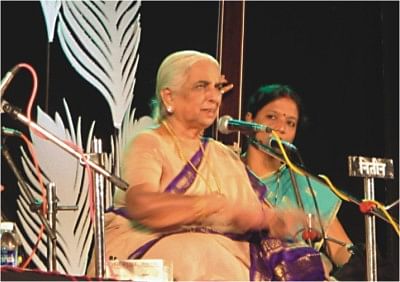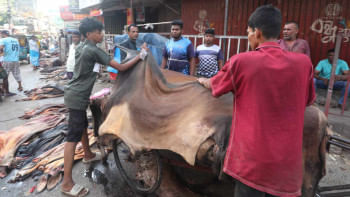Vocalist Girija Devi: Music that tugs at the heartstrings

Girija Devi during a performance.
I first heard Girija Devi in a live performance way back in 2006 at New Delhi's Nehru Park. It was organised by Spic Macay (also known as the Society for Promotion of Indian Classical Music and Culture Amongst Youth) New Delhi. It was an amazing experience since I had only heard her recorded performances before that.
Rumors were rife that she was in poor health. But when I heard her perform at Nehru Park, I felt that she had offered some really great music to her audience, laying to rest any fears of her diminishing musical capabilities. Before that performance she had just had an open heart surgery. As a devoted fan of hers, I was excited at that time to listen to her live performance. I felt that her voice was like a sensitive seismograph. Equally astounding was her vivid imagination, which lent a new dimension to whatever she sang.
Although in her late 70s now, her music reflects the old involvement and abundance. At her performance, she sang a khayal based on “Raga Khamaj.” She was accompanied on the tabla by Pandit Kishan Maharaj. It was a scintillating experience for me to listen to two maestros of Varanasi together. Subsequently she sang Chaiti Kajri and of course her specialty, thumri.
Girija is one of the last masters of the Purab ang gayaki tradition of the Banaras Gharana (school of music). She has been equally effective singing in the traditional 18th century classical style of khayal as well as semi-classical styles such as thumri, tappa, kajri, dadra, and chaiti.
The recipient of the prestigious Padma Shri Award (in 1972) and the Padma Bhushan (in 1989), she has also received the Sangeet Natak Academy Awards of Uttar Pradesh and Delhi. Born in Varanasi (formerly Banaras), an ancient cultural/religious centre located on the left bank of the Ganges river, Girija has been singing much of her life. Studying with influential vocalist and sarangi player Pandit Sarju Prasad from the age of five, she later continued her studies with Pandit Chandra Misra. She made her debut appearance in 1949 during a recital that was broadcast by the All India Radio station in Allahabad.
Girija performed in her first concert a year later. Teaching at the ITC Sangeet Research Academy from its inception in the early '90s, she served as guru for many students, including Dalia Rahut, Jayita Pandey, and Satyanarayan Misra, the son of her own guru, Pandit Sarju Prasad. Leaving the school after 12 years, she returned to Varanasi, where she became a visiting professor at Banaras Hindu University.
Her brilliant renderings of light classical music have tugged at the heartstrings of audiences worldwide. In her huge repertoire of khayal, thumri, gul, naksh, prabandha, dadra, tappa, kajri, chaiti and bhajan and many others, she emphasises the beauty of the lyrics. When in full flow, her voice, with its resonance and timbre, sonorously recaptures the rich melody of a shehnai. Her stimulating performances reveal her sensitivity, erudition and versatility as a vocalist. Endowed with a divine magic in the depths of her voice, every recital of hers blesses her listeners with a sense of profound fulfilment.

 For all latest news, follow The Daily Star's Google News channel.
For all latest news, follow The Daily Star's Google News channel. 



Comments